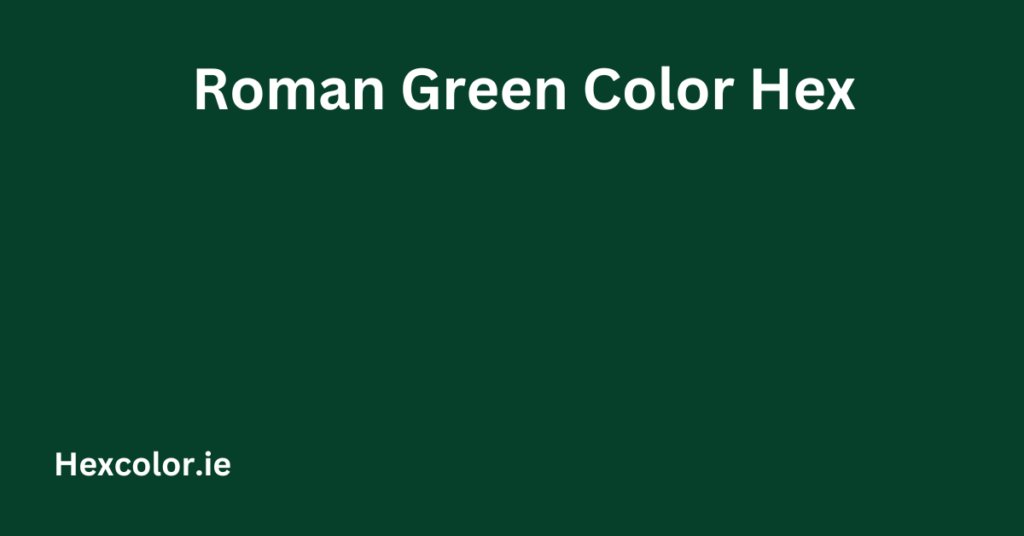
What is Green?
Roman Green Color Hex Code #06402b is a versatile and deeply symbolic color that sits between blue and yellow on the color wheel. It represents nature, growth, and renewal, making it one of the most frequently used colors in branding, interior design, and digital interfaces. Its connection to vitality and sustainability makes it a preferred choice for eco-friendly brands and wellness-focused aesthetics.
How Green Appears on Digital Screens
To ensure consistency across various screens and devices, green is defined by the following color codes:
| Property | Value |
|---|---|
| HEX Code | #008000 |
| RGB | 0, 128, 0 |
| HSL | 120, 100%, 25% |
| CMYK | 100%, 0%, 100%, 50% |
These values guarantee that green maintains its vibrancy and intended appearance across digital platforms.
How to Use Green Effectively in UI Design
Green offers a broad spectrum of hues, from bright lime to deep forest green, making it highly adaptable. Here are some key ways to use green effectively in UI and UX design:
1. Creating a Natural Connection
Green’s strong association with nature makes it ideal for eco-conscious brands, sustainability initiatives, and organic product lines.
2. Evoking Harmony and Balance
Lighter shades of green exude calmness, making them suitable for meditation apps, mental wellness platforms, and relaxation-focused interfaces.
3. Signaling Growth and Success
Green is frequently used to symbolize progress and positive actions. Many financial apps use green for profit indicators and successful transactions.
4. Highlighting Key UI Elements
Green can be used effectively for call-to-action (CTA) buttons, notifications, and primary navigation elements, as it stands out without overwhelming the user.
Similar Colors to Green
If you’re looking for variations of green to enrich your designs, consider these shades:
Colors That Pair Well with Green
Green’s versatility allows it to pair well with various colors, creating different moods and aesthetics:
Colors That Clash with Green
While green is adaptable, some color combinations may create a jarring effect:
| Color Name | HEX Code |
| Neon Pink | #FF69B4 |
| Bright Red | #FF0000 |
| Dark Purple | #800080 |
| Electric Blue | #00F0FF |
| Bright Yellow | #FFFF00 |
The Symbolism of Green
Green carries rich symbolic meanings across different cultures and design contexts:
- Nature & Growth: Representing renewal, life, and sustainability.
- Balance & Harmony: Often used to evoke calmness and relaxation.
- Prosperity & Wealth: Associated with financial success, particularly in Western cultures.
- Health & Well-being: Frequently used in wellness brands and medical applications.
The History of Green
Green has played a significant role throughout history:
- Ancient Egypt: Associated with fertility and rebirth, often linked to Osiris, the god of vegetation.
- Roman Era: A symbol of victory and renewal, used in laurel wreaths.
- Middle Ages: Represented both love and envy, highlighting its dual nature.
- Renaissance: Became a symbol of wealth due to the difficulty of producing green pigments.
- Modern Era: Associated with environmentalism and sustainability movements.
Variations and Harmonies of Green
To create aesthetically pleasing designs, consider these green-based color harmonies:
| Harmony Type | Colors |
| Complementary | Green (#008000) + Purple (#800080) |
| Split-Complementary | Green (#008000) + Navy Blue (#400080) + Magenta (#800040) |
| Monochromatic | Green (#008000) + Dark Green (#006600) + Lime Green (#009A00) |
| Analogous | Green (#008000) + Olive Green (#408000) + Teal (#008040) |
| Triadic | Green (#008000) + Blue (#000080) + Red (#800000) |
| Square | Green (#008000) + Deep Blue (#004080) + Purple (#800080) + Brown (#804000) |
Accessibility Considerations
Ensuring green is accessible to all users is crucial in UI/UX design. Consider contrast ratios for readability:
| Background Color | Contrast Ratio | Pass/Fail |
| White (#FFFFFF) | 5.14:1 | Pass (AA Normal), Fail (AAA) |
| Black (#000000) | 4.09:1 | Fail (AA Normal), Pass (Large Text) |
For inclusive design, tools like Figma’s accessibility plugins help designers ensure compliance with Web Content Accessibility Guidelines (WCAG).
Green in Color Simulations (Color Blindness)
Green may appear differently depending on color vision deficiencies:
| Color Blindness Type | Appearance |
| Protanopia | Dull or brownish |
| Deuteranopia | Muted or reddish |
| Tritanopia | Darker, teal-like shade |
| Achromatopsia | Grayscale tone |
Color Conversion for Different Applications
Green can be translated into different formats for various design and development platforms:
| Platform | Code |
| iOS – SwiftUI | Color(red: 0/255, green: 128/255, blue: 0/255) |
| iOS – UIKit | UIColor(red: 0/255.0, green: 128/255.0, blue: 0/255.0, alpha: 1.0) |
| Android – Compose | Color(0xFF008000) |
Conclusion
Green is a dynamic and influential color in design, offering endless possibilities for branding, UI/UX, and aesthetic appeal. Whether used to convey harmony, sustainability, or growth, green is a timeless choice that continues to inspire designers worldwide. By understanding its nuances, you can leverage green effectively to create stunning and meaningful designs.


